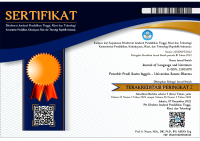Exploring Teenager’s Language Attitudes towards Javanese Language
(1) Universitas Sanata Dharma
(2) Universitas Sanata Dharma
(3) Universitas Sanata Dharma
(*) Corresponding Author
Abstract
Language attitudes significantly influence language vitality and revitalization, shaping users' language choices. In Indonesia, indigenous languages, including Javanese, are declining in use, particularly among younger generations who prefer Indonesian for daily communication. Family language policies, where parents prioritize Indonesian over indigenous languages, contribute to this trend. This study investigates teenagers’ language attitudes towards Javanese, aiming to inform strategies for preserving the language. Using a mixed-method sociolinguistic approach, the researchers collected data through surveys and interviews, examining factors like cultural identity, social dynamics, educational experiences, and media exposure. The study involves Junior High School students, with 127 survey responses and 42 respondents joining the interviews. The findings reveal that 44.1% of respondents learned Javanese as their mother tongue, while 55.1% acquired Indonesian. Proficiency in Javanese varies: 41.7% can fluently use Javanese Ngoko, but only 4.7% are fluent in Krama. Javanese Ngoko is mainly used within families and local communities, whereas Indonesian dominates in schools and public spaces, influenced by its perceived utility and globalization. Despite challenges, including limited learning resources and fear of misuse, respondents view Javanese positively, driven by cultural pride and ethnic identity. These findings highlight the need for targeted strategies to empower teenagers to preserve and revitalize Javanese. Addressing language attitudes and increasing exposure to Javanese could help reverse its decline.
Keywords
Full Text:
PDFReferences
Atmawati, D. (2021). Language Politeness in the Javanese Verb Speech Level. Lingua Cultura, 15(1), 51 - 57. doi:https://doi.org/10.21512/lc.v15i1.7109
Cohn, A. C., & Ravindranath, M. (2014). Local Languages in Indonesia: Language Maintenance or Language Shift? Linguistik Indonesia, 32(2), 131 - 148. doi:https://doi.org/10.26499/li.v32i2.22
Curdt-Christiansen, X. & Lanza, E. (2018). Language management in multilingual families: Efforts, measures, and challenges. Multilingua, 37(2), 123-130. https://doi.org/10.1515/multi-2017-0132
Ethnologue. (2024, February 6). Javanese. Retrieved 2024, from Ethnologue: https://www.ethnologue.com/language/jav/
Extra, G., & Yagmur, K. (2010). Language proficiency and socio-cultural orientation of Turkish and Moroccan youngsters in the Netherlands. Language and Education, 117 - 132. 10.1080/09500780903096561
Fitriati, A. (2023). The Family Language Policy of Javanese Multilingual Families. Journal of Language and Literature, 23(2), 405-415. https://doi.org/10.24071/joll.v23i2.7020
Hernández-Campoy, J. M. (2015, May 22). AILA Review, 5 - 29. doi:https://doi.org/10.1075/aila.27.01her
Hollebeke, I., Struys, E., & Agirdag, O. (2020). Can family language policy predict linguistic, socio-emotional, and cognitive child and family outcomes? A systematic review. Journal of Multilingual and Multicultural Development, 44(10), 1044-1075. doi:https://doi.org/10.1080/01434632.2020.1858302
Kasstan, J. R., Auer, A., & Salmons, J. (2018). Heritage-language speakers: Theoretical and empirical challenges on sociolinguistic attitudes and prestige. International Journal of Bilingualism, 387 - 394. 10.1177/1367006918762151
Kesbi, A. (2018, - -). Language Attitudes in Sociolinguistic Research: A methodological perspective. Retrieved from Academia.Edu: https://www.academia.edu/45602964/Language_Attitudes_in_Sociolinguistic_Research_A_methodological_perspective
King, K. A., & Fogle, L. W. (2013). Family Language Policy and Bilingual Parenting. Language Teaching, 46(2), 172 - 194. doi:10.1017/S0261444812000493
Languages, U. A. (2003, March 10 - 12). ich.unesco.org. Retrieved 2024, from UNESCO Intangible Heritage: https://ich.unesco.org/doc/src/00120-EN.pdf
Li, C., & Wei, L. (2022). Language attitude: construct, measurement, and associations with language achievements. Journal of Multilingual and Multicultural Development, 1-24. https://doi.org/10.1080/01434632.2022.2137516
Nur, T. (2021). Betawi Adolescents’ Language Attitudes Towards Their Mother Tongue: A Sociolinguistic Perspective in Indonesia. Proceedings of the International Congress of Indonesian Linguistics Society (KIMLI 2021) (pp. 63 - 67). Makasar: Atlantis Press. doi:https://doi.org/10.2991/assehr.k.211226.015
Nur, T., Lukman, Kaharuddin, & Dafirah. (2021). Language Attitudes of Betawi Teenagers Toward their Mother Tongue: A Sociolinguistic Perspective. TESOL International Journal, 16(1), 102 - 118. Retrieved from https://www.elejournals.com/tij-2021/tij-volume-16-issue-1-2021/
Polinsky, M., & Kagan, O. (2007). Heritage Languages: In the ‘Wild’ and in the Classroom. Language and Linguistics Compass, 1(5), 368 - 395. https://doi.org/10.1111/j.1749-818X.2007.00022.x
Ramli, Setyawan, F. H., & Rampeng. (2019). The Threat of Lingua Globalization towards Vernaculars in South Sulawesi. Journal Etnografi Indonesia, 6(1), 230 - 240. doi:10.31947/etnosia.v6i2.18197
Sefrianus Rianto, & I Made Juliarta. (2024). The Impact of Social Media on Language Use Among Teenagers. Focus Journal Language Review, 2(2). https://doi.org/10.62795/fjlg.v2i2.297
Sakhiyya, Z., & Martin-Anatias, N. (2023). Reviving the language at risk: a social semiotic analysis of the linguistic landscape of three cities in Indonesia. International Journal of Multilingualism, 290-307. https://doi.org/10.1080/14790718.2020.1850737
Spolsky, B. (2012). Family Language Policy - the Critical Domain. Journal of Multilingual and Multicultural Development, 3-11. https://doi.org/10.1080/01434632.2011.638072
Udasmoro, W., S, E., Sulistyowati, S., Firmonasari, A., Astuti, W. T., & Baskoro, B. S. (2023). The Preservation of the Javanese Language in the Special Region of Yogyakarta. Indonesian Journal of Geography, 55(1), 59-68. https://doi.org/10.22146/ijg.68183
Udasmoro, W., Sulistyowati, S., Firmonasari, A., & Astuti, W. T. (2023). Access to and Usage of Javanese in Mass Media among Yogyakarta Youth. Journal of Language and Literature, 268 - 277. https://doi.org/10.24071/joll.v23i2.5508
Udasmoro, W., Yuwono, J. S., Sulistyowati, Firmonasari, A., Astuti, W. T., & Baskoro, B. S. (2023). The Preservation of the Javanese Language in the Special Region of Yogyakarta. Indonesian Journal of Geography, 59-68. https://doi.org/10.22146/ijg.68183
Ulfa, M. (2019). Eksistensi Bahasa Daerah di Era Disrupsi. Stilistika: Jurnal Pendidikan Bahasa Dan Sastra, 12(2), 197 - 207. https://doi.org/10.30651/st.v12i2.2948
DOI: https://doi.org/10.24071/joll.v25i1.10539
Refbacks
- There are currently no refbacks.

This work is licensed under a Creative Commons Attribution-ShareAlike 4.0 International License.
Journal of Language and Literature (JOLL) is published by Prodi Sastra Inggris, Fakultas Sastra, Universitas Sanata Dharma.
JOLL is indexed in:

This journal is is licensed under a Creative Commons Attribution-ShareAlike 4.0 International License













